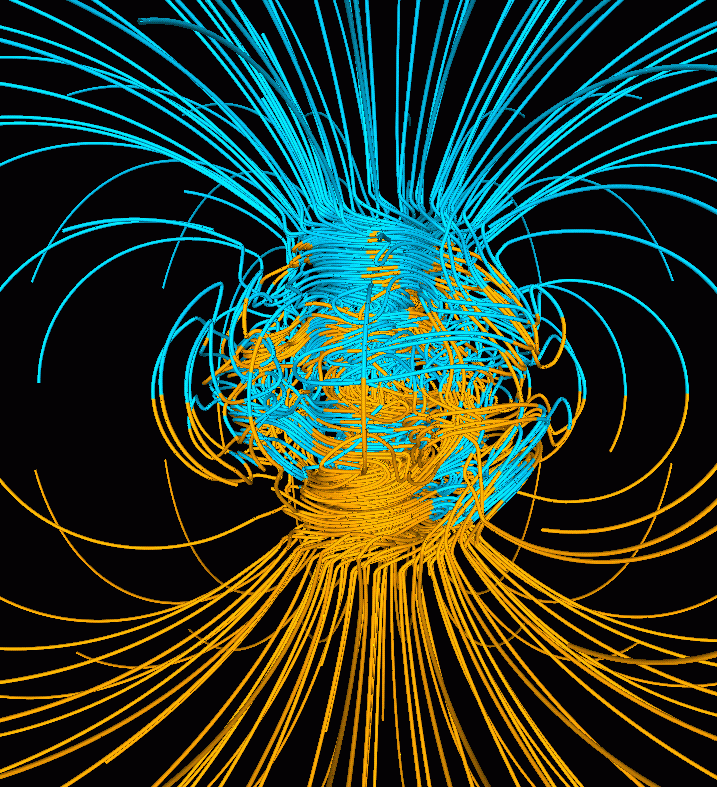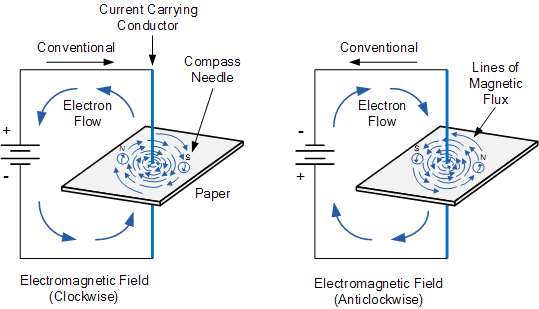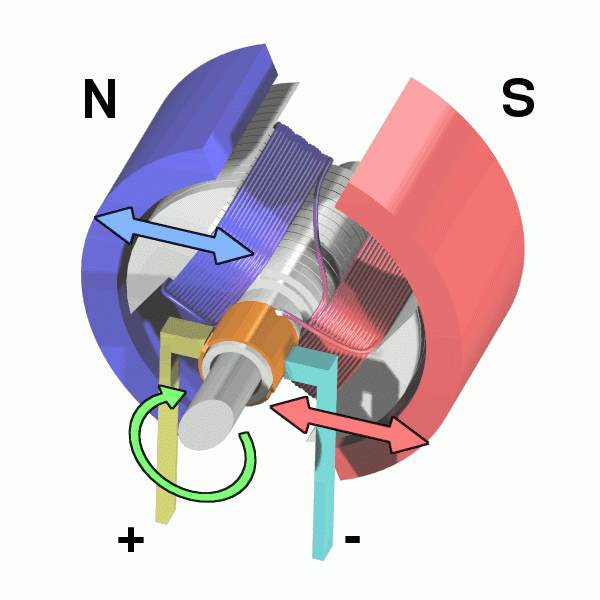Magnetic Forces


Magnetic fields are caused by moving charges. In permanent magnets, electron spinning causes the magnetic fields, Atoms are arranged in small structures called domains where the electrons spin in the same direction. Each domain acts as a small magnet. materials that have random domains do not form magnetic fields. In some other materials, the domains are organized so that the magnetic field of each domain adds up to a larger magnetic field.
Every magnet exists as a dipole with a North and South pole. opposite poles attract while like poles repel. An external magnetic field can cause the domains of another material to be aligned. On the other hand, the domains of a magnet can be scrambled (made random) by heating, shock or by the presence of other stronger magnetic fields.
Like an electric field, the magnetic field is a vector, its direction is determined by the direction of a north-pointing compass needle. Field lines leave the north pole and enter the south pole. Therefore, the field lines of a magnet form closed loops. The geographic North pole is the Magnetic South pole.

Charged particles including those from the sun are trapped in a part of the earths magnetic field. These particles collide with gas exiting them to release energy in the form of light producing the Northern and Southern lights. Solar flares are also phenomena arising from strong magnetic fields. Magnetic field strength is measured in Teslas (T).
Magnetic flux is a measure of how many magnetic field lines move through an object and is related to magnetic field strength.
Orsted discovered that electrons moving in the current also produce magnetic fields. The magnetic field is circular around the wire and always at right angles to the wire. In a law developed by Andre Marie Ampere, (Ampere's law), it was shown that the strength of the magnetic field varies directly as the current and inversely as the distance from the wire.

The direction of the magnetic fields around a conductor can be determined by using the right-hand rule. The right-hand rule is used for conventional current and the movement of positive charge. On the other hand (literally) the left-hand rule is used for electron current
When a wire carrying a current is formed into a loop, the magnetic field is increased. The magnetic field of a wire coil (solenoid) is very similar to that of a bar magnet. The field strength inside the coil varies directly as the number of loops in the coil and directly as the current. The strength is uniform and strong inside the coil but weak outside the coil.
To determine the direction of magnetic field caused by a current-carrying coil, fold the fingers in direction of the current flow in the coil, point the thumb straight out so that it points in the direction of the North pole of the electromagnet. Use left hand for electron current and right hand for conventional current.
When charged particles move through a magnetic field, they experience a force which deflects them. The magnetic force of the particle is 0 if the particle's velocity is parallel to the magnetic field. The magnetic field does not work on the charges.
Another hand rule (the third) relates to the direction of the force acting on a particle as it moves through and external magnetic field. The thumb is the direction of charge motion. The fingers point to the field direction, towards the south pole. and the palm indicates the direction of the magnetic force of the charged particle. Use the left hand for negative charges and the right hand for positive charges.
The magnitude of the force on the particle depends on the magnetic field strength, the charge on the particle and the velocity of the particle. The magnetic force on the particle is 0 if the particles velocity is parallel to the magnetic field.

An electric motor is an electrical machine that converts electrical energy into mechanical energy. Most electric motors operate through the interaction between the motor's magnetic field and electric current in a wire winding to generate force in the form of torque applied on the motor's shaft. An electric motor consists of a Stator, which is a frame with a coil or permanent magnet to provide a magnetic field. A Rotor (Armature) is the rotating loop of coil consisting of conducting wire on the shaft. The commutator is a split metal ring. Because the magnetic force applied to a particle is perpendicular to the velocity, the particle travels in a circular path. The magnetic force behaves as a centripetal force.
This is the phenomenon where a conductor in a magnetic field is used to cause a current to flow in the conductor. The magnetic field exerts a force on the electrons on the wire causing them to move. There are at three different ways to induce a current:
By spinning a turbine, you can either move a magnet near a conductor or move a conductor near a magnet. The magnetic flux through the loop is always changing therefore an alternating current is produced.
Transformers are designed to change the level of current from an incoming (input) line to an outgoing (output) line. There is no electrical connection between the input and output, they only interact through a changing magnetic field. Coils are used, would on an iron core to concentrate the magnetic field. The voltage can be increased (stepped up) or decreased (stepped down) but energy is usually conserved between the input and output lines, accounting for some energy loss due to the efficiency of the transformer.
If V is increased 3X, I (current) will reduce by the same factor. as in: